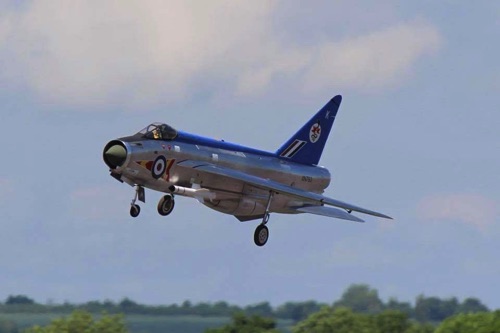PPMFC
I built this model from the Mick Reeves kit. It has a fibreglass fuselage, and traditional built up wings with spars and ribs from plywood, sheeted with 1/8” balsa which I covered with fine weave epoxy-glass. It is 1/7 scale, 85” long, with a wingspan of 60”. It weighs 30lbs without fuel, has a 1 gallon fuel tank, a gallon of fuel adds another 8lbs to its take off weight. That gives it a 6 minute flight with a ¼ tank of fuel left in reserve in case of needing to go around or delay landing. Engine is a single Wren 160 of 160 Newtons or 35lbs static thrust, working through the upper of the two jet pipes. The whole model is covered in a product called “Flite-Metal” which is a thick, self-adhesive aluminium foil, and needs a lot of hard work to form it to the compound curves and then sand and polish to the correct flat finish. It has a working brake parachute, and afterburner LED rings.
The radio uses 18 channels to control all the servos, valves and electronic controllers. Radio has dual-path redundant transmission from the transmitter to two receivers which transfer the signal to a main power distribution box. The power distribution box handles power regulation from the two lithium-ion batteries that have a total of 10,400mAh capacity, chooses which receiver data to use, and drives many of the servos etc. There are 5 servos in the tail (2 x all moving tailplanes, rudder, brake chute housing doors, brake chute cable release) so rather than run 5 sets of long servo cables all that way and through connectors where the fuselage splits for transport, I fitted a dual-redundant digital data bus and large capacity power cables from the main power box to a smaller power box in the tail which converts the digital data and sends it to the relevant servo.
Flight handling is quite good, the highly swept wing is very tolerant of angles of attack but is poor at generating lift, so turns and loops tend to be large. However highly swept wings are not very stable in roll and are easily upset by mild turbulence, so a gyro is fitted but just on the roll axis. Orientation is a major problem, with a mid-wing and a small span in relation to its size. Also, the sun reflecting off the aluminium can be dazzling and all you can see at some moments is a shapeless bright flash in the sky, so I have recently toned it down with a dirty wash.
The retracts cause a considerable change in centre of gravity and thus a big change in elevator trim. The main legs retract along the wing sweep angle, so they are special 60 degree twist and turn units to get the wheel to lie flat inside the wing. The legs are long because it is a mid wing plane, the wheels are very big and have brake units so they are quite heavy at the end of long legs which themselves have to be heavy to be strong enough, so because they move a long way back and forward when up or down, the CG shifts a lot. The flaps cause a big elevator trim change, and the engine thrust operating through just the top jet pipe also causes a trim change as throttle is moved up and down. This makes it a very entertaining time in the landing circuit as the wheels coming down pushes the nose down, then each of the two flap settings push the nose up each time, and changing the throttle pushes the nose up or down! Combinations of flight mode slow transitions, flight mode trims, and mixing removes most of the effects, but early flights before the correct settings were found got rather busy trying to keep the model level!











